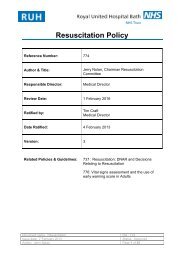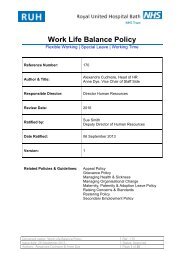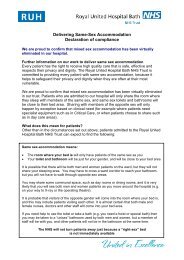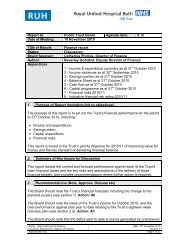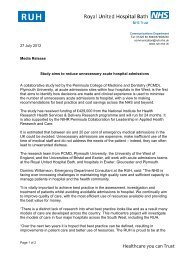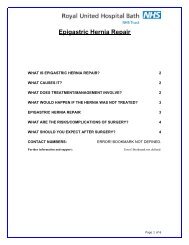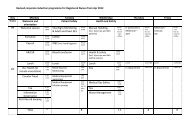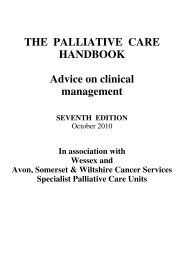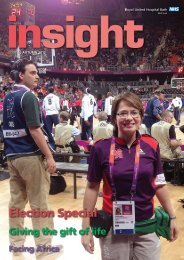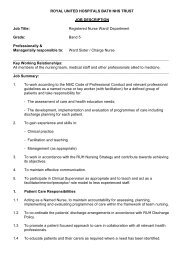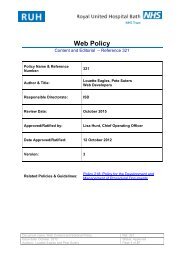(NPWT) including Vacuum Assisted Closure (Vac) - Royal United ...
(NPWT) including Vacuum Assisted Closure (Vac) - Royal United ...
(NPWT) including Vacuum Assisted Closure (Vac) - Royal United ...
Create successful ePaper yourself
Turn your PDF publications into a flip-book with our unique Google optimized e-Paper software.
13. When to discontinue <strong>NPWT</strong><br />
• <strong>NPWT</strong> is associated with a significant cost implication, therefore there should be<br />
regular reassessments of the need to continue <strong>NPWT</strong>. Reviews should be<br />
undertaken by registered nurses with RUH <strong>NPWT</strong> competencies & occur at least<br />
weekly. The TVN can be contacted for advice and or assistance with<br />
reassessments.<br />
• <strong>NPWT</strong> should be only be discontinued in discussion with the TVN or the patients’<br />
medical team. However, if there is a serious problem such as<br />
excessive/uncontrolled bleeding or pain, stop the therapy immediately.<br />
• Discontinue <strong>NPWT</strong> therapy if it no longer appears to be effective and the wound<br />
has become ‘static’ i.e. there is no new granulation tissue after one week.<br />
Discuss with TVN whether <strong>NPWT</strong> should be continued.<br />
• Exudate levels are so low that the wound is drying out.<br />
• The wound has reached a stage at which <strong>NPWT</strong> therapy is no longer required i.e.<br />
has granulated up to the level of the surrounding skin.<br />
• The patient is unable to be discharged / transferred with <strong>NPWT</strong> therapy.<br />
14. User responsibilities<br />
It is the responsibility of the clinical staff that use <strong>NPWT</strong> to:<br />
• Refer all patients on <strong>NPWT</strong> to the Tissue Viability team through Millennium.<br />
• Only use <strong>NPWT</strong> once they have received approved RUH <strong>NPWT</strong> training and<br />
completed the <strong>NPWT</strong> competencies.<br />
• Be familiar with RUH policies and protocols, relevant company information and<br />
instructions, prior to using the therapy (see Tissue Viability intranet for the latest<br />
resources).<br />
• Ensure that the <strong>NPWT</strong> policy and all relevant literature are available for all<br />
members of the multidisciplinary team responsible for the patient.<br />
Document name: Negative Pressure Wound Therapy (<strong>NPWT</strong>) Ref.: 745<br />
Issue date: 10 June 2013<br />
Status: Approved<br />
Author: Kate Purser and Nicola Heywood Page 12 of 20



